Impact of Sex Role Transformations in the Years 1900-1945
VerifiedAdded on 2022/09/01
|8
|2162
|21
Essay
AI Summary
This essay examines the profound transformations in sex roles between 1900 and 1945, a period marked by the cataclysmic events of the First and Second World Wars. It explores how these global conflicts precipitated significant shifts in societal norms, particularly regarding women's roles in the family and the workforce. The paper highlights the increased freedom and opportunities afforded to women, including the ability to work after marriage and assume roles traditionally held by men. It also analyzes the evolving concepts of masculinity and feminism, emphasizing the impact of women's participation in war efforts and the subsequent empowerment. The essay discusses the active involvement of women in the military, challenging traditional gender roles and contributing to the redistribution of power within society. The study concludes by emphasizing the importance of this era in the advancement of women's rights and the deconstruction of patriarchal myths, paving the way for greater equality in education, employment, and political participation. The essay references multiple scholarly sources to support its arguments.
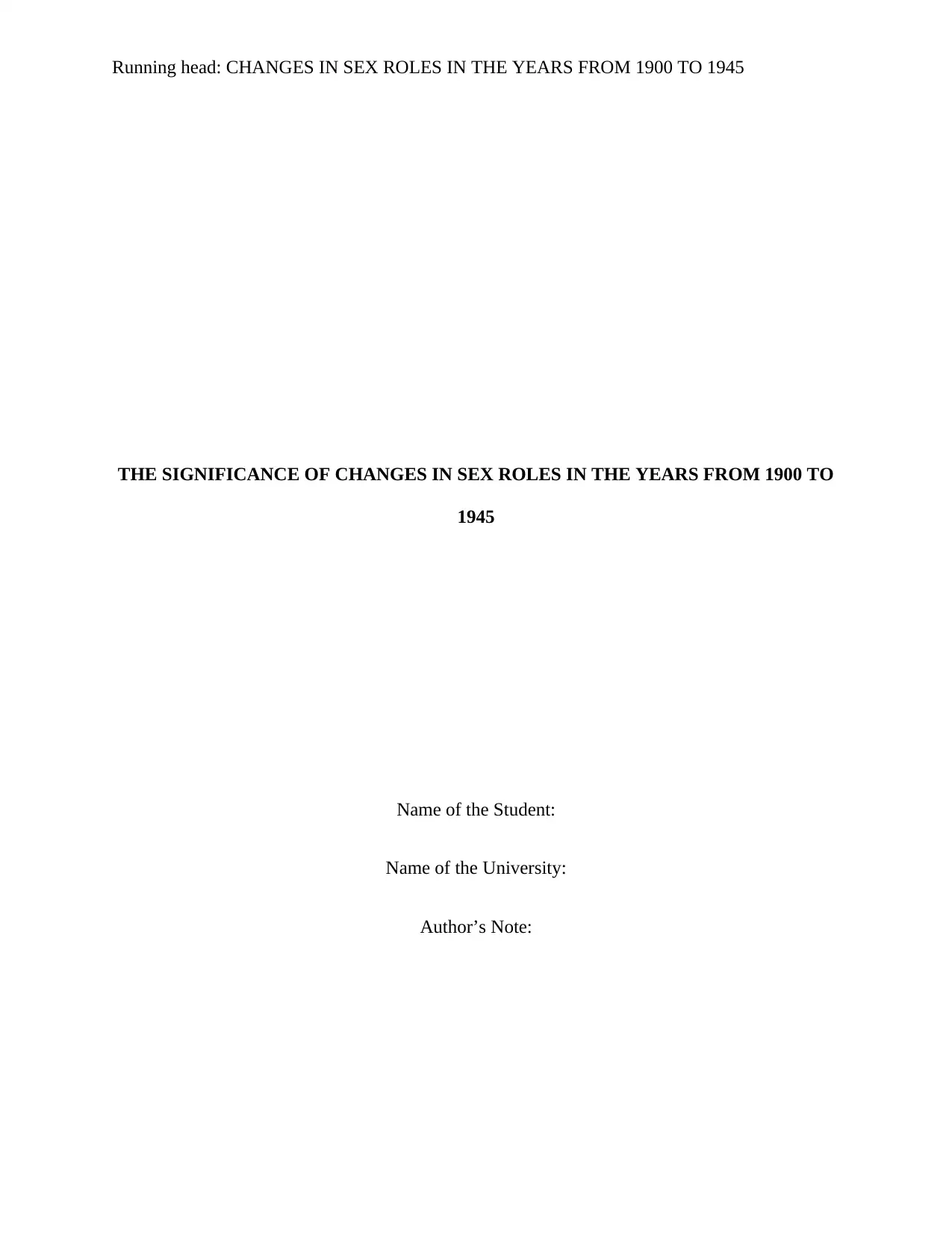
Running head: CHANGES IN SEX ROLES IN THE YEARS FROM 1900 TO 1945
THE SIGNIFICANCE OF CHANGES IN SEX ROLES IN THE YEARS FROM 1900 TO
1945
Name of the Student:
Name of the University:
Author’s Note:
THE SIGNIFICANCE OF CHANGES IN SEX ROLES IN THE YEARS FROM 1900 TO
1945
Name of the Student:
Name of the University:
Author’s Note:
Paraphrase This Document
Need a fresh take? Get an instant paraphrase of this document with our AI Paraphraser
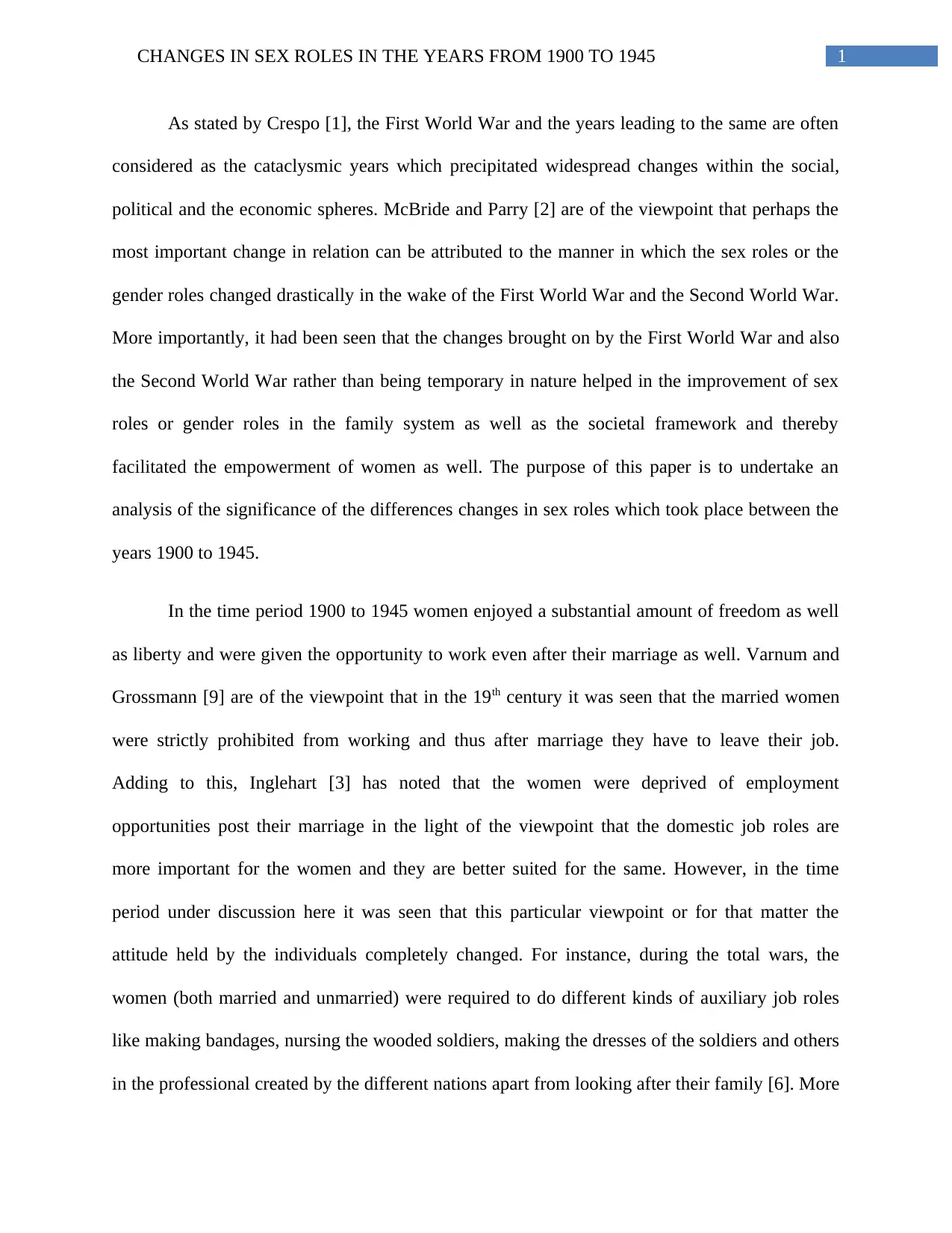
1CHANGES IN SEX ROLES IN THE YEARS FROM 1900 TO 1945
As stated by Crespo [1], the First World War and the years leading to the same are often
considered as the cataclysmic years which precipitated widespread changes within the social,
political and the economic spheres. McBride and Parry [2] are of the viewpoint that perhaps the
most important change in relation can be attributed to the manner in which the sex roles or the
gender roles changed drastically in the wake of the First World War and the Second World War.
More importantly, it had been seen that the changes brought on by the First World War and also
the Second World War rather than being temporary in nature helped in the improvement of sex
roles or gender roles in the family system as well as the societal framework and thereby
facilitated the empowerment of women as well. The purpose of this paper is to undertake an
analysis of the significance of the differences changes in sex roles which took place between the
years 1900 to 1945.
In the time period 1900 to 1945 women enjoyed a substantial amount of freedom as well
as liberty and were given the opportunity to work even after their marriage as well. Varnum and
Grossmann [9] are of the viewpoint that in the 19th century it was seen that the married women
were strictly prohibited from working and thus after marriage they have to leave their job.
Adding to this, Inglehart [3] has noted that the women were deprived of employment
opportunities post their marriage in the light of the viewpoint that the domestic job roles are
more important for the women and they are better suited for the same. However, in the time
period under discussion here it was seen that this particular viewpoint or for that matter the
attitude held by the individuals completely changed. For instance, during the total wars, the
women (both married and unmarried) were required to do different kinds of auxiliary job roles
like making bandages, nursing the wooded soldiers, making the dresses of the soldiers and others
in the professional created by the different nations apart from looking after their family [6]. More
As stated by Crespo [1], the First World War and the years leading to the same are often
considered as the cataclysmic years which precipitated widespread changes within the social,
political and the economic spheres. McBride and Parry [2] are of the viewpoint that perhaps the
most important change in relation can be attributed to the manner in which the sex roles or the
gender roles changed drastically in the wake of the First World War and the Second World War.
More importantly, it had been seen that the changes brought on by the First World War and also
the Second World War rather than being temporary in nature helped in the improvement of sex
roles or gender roles in the family system as well as the societal framework and thereby
facilitated the empowerment of women as well. The purpose of this paper is to undertake an
analysis of the significance of the differences changes in sex roles which took place between the
years 1900 to 1945.
In the time period 1900 to 1945 women enjoyed a substantial amount of freedom as well
as liberty and were given the opportunity to work even after their marriage as well. Varnum and
Grossmann [9] are of the viewpoint that in the 19th century it was seen that the married women
were strictly prohibited from working and thus after marriage they have to leave their job.
Adding to this, Inglehart [3] has noted that the women were deprived of employment
opportunities post their marriage in the light of the viewpoint that the domestic job roles are
more important for the women and they are better suited for the same. However, in the time
period under discussion here it was seen that this particular viewpoint or for that matter the
attitude held by the individuals completely changed. For instance, during the total wars, the
women (both married and unmarried) were required to do different kinds of auxiliary job roles
like making bandages, nursing the wooded soldiers, making the dresses of the soldiers and others
in the professional created by the different nations apart from looking after their family [6]. More
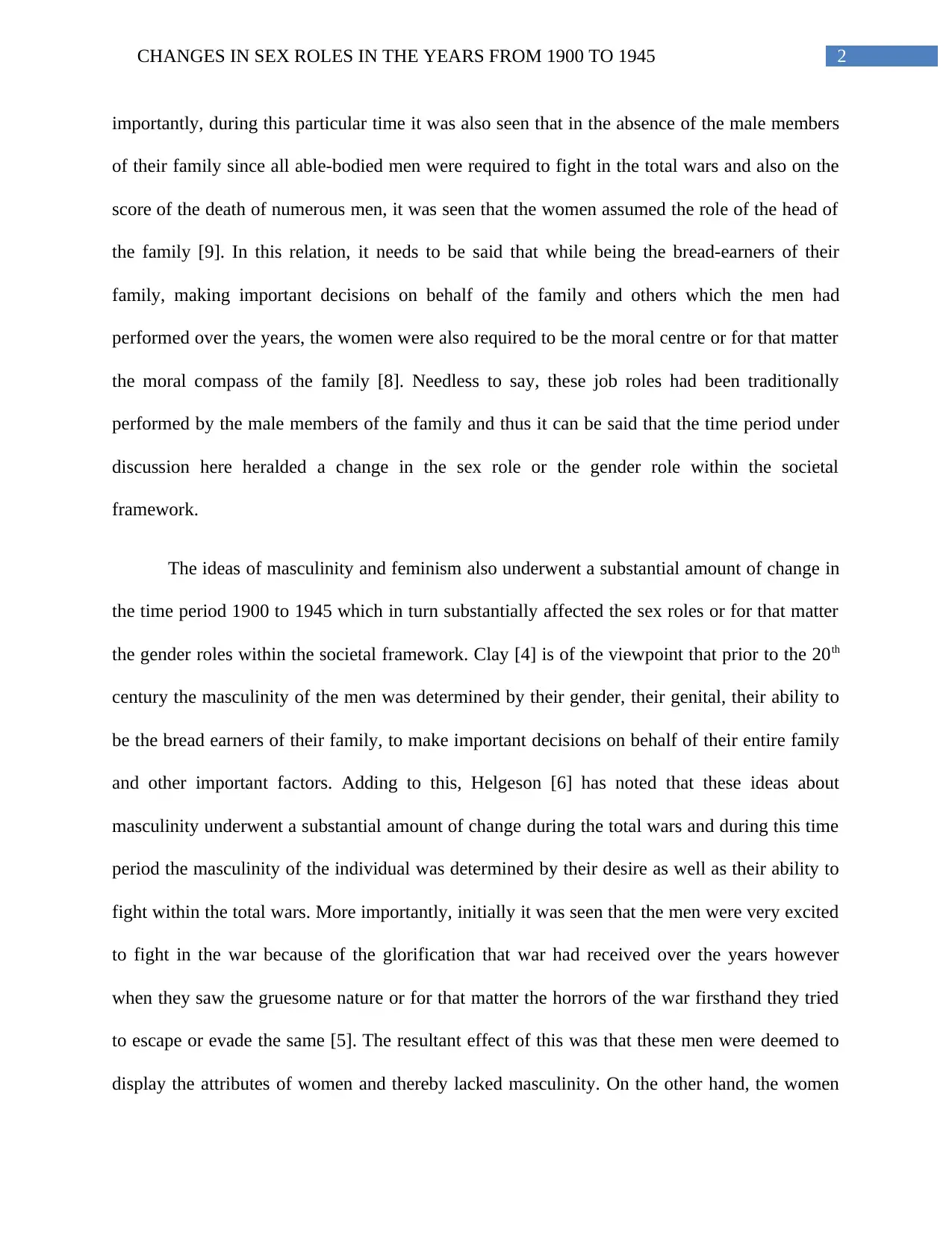
2CHANGES IN SEX ROLES IN THE YEARS FROM 1900 TO 1945
importantly, during this particular time it was also seen that in the absence of the male members
of their family since all able-bodied men were required to fight in the total wars and also on the
score of the death of numerous men, it was seen that the women assumed the role of the head of
the family [9]. In this relation, it needs to be said that while being the bread-earners of their
family, making important decisions on behalf of the family and others which the men had
performed over the years, the women were also required to be the moral centre or for that matter
the moral compass of the family [8]. Needless to say, these job roles had been traditionally
performed by the male members of the family and thus it can be said that the time period under
discussion here heralded a change in the sex role or the gender role within the societal
framework.
The ideas of masculinity and feminism also underwent a substantial amount of change in
the time period 1900 to 1945 which in turn substantially affected the sex roles or for that matter
the gender roles within the societal framework. Clay [4] is of the viewpoint that prior to the 20th
century the masculinity of the men was determined by their gender, their genital, their ability to
be the bread earners of their family, to make important decisions on behalf of their entire family
and other important factors. Adding to this, Helgeson [6] has noted that these ideas about
masculinity underwent a substantial amount of change during the total wars and during this time
period the masculinity of the individual was determined by their desire as well as their ability to
fight within the total wars. More importantly, initially it was seen that the men were very excited
to fight in the war because of the glorification that war had received over the years however
when they saw the gruesome nature or for that matter the horrors of the war firsthand they tried
to escape or evade the same [5]. The resultant effect of this was that these men were deemed to
display the attributes of women and thereby lacked masculinity. On the other hand, the women
importantly, during this particular time it was also seen that in the absence of the male members
of their family since all able-bodied men were required to fight in the total wars and also on the
score of the death of numerous men, it was seen that the women assumed the role of the head of
the family [9]. In this relation, it needs to be said that while being the bread-earners of their
family, making important decisions on behalf of the family and others which the men had
performed over the years, the women were also required to be the moral centre or for that matter
the moral compass of the family [8]. Needless to say, these job roles had been traditionally
performed by the male members of the family and thus it can be said that the time period under
discussion here heralded a change in the sex role or the gender role within the societal
framework.
The ideas of masculinity and feminism also underwent a substantial amount of change in
the time period 1900 to 1945 which in turn substantially affected the sex roles or for that matter
the gender roles within the societal framework. Clay [4] is of the viewpoint that prior to the 20th
century the masculinity of the men was determined by their gender, their genital, their ability to
be the bread earners of their family, to make important decisions on behalf of their entire family
and other important factors. Adding to this, Helgeson [6] has noted that these ideas about
masculinity underwent a substantial amount of change during the total wars and during this time
period the masculinity of the individual was determined by their desire as well as their ability to
fight within the total wars. More importantly, initially it was seen that the men were very excited
to fight in the war because of the glorification that war had received over the years however
when they saw the gruesome nature or for that matter the horrors of the war firsthand they tried
to escape or evade the same [5]. The resultant effect of this was that these men were deemed to
display the attributes of women and thereby lacked masculinity. On the other hand, the women
⊘ This is a preview!⊘
Do you want full access?
Subscribe today to unlock all pages.

Trusted by 1+ million students worldwide
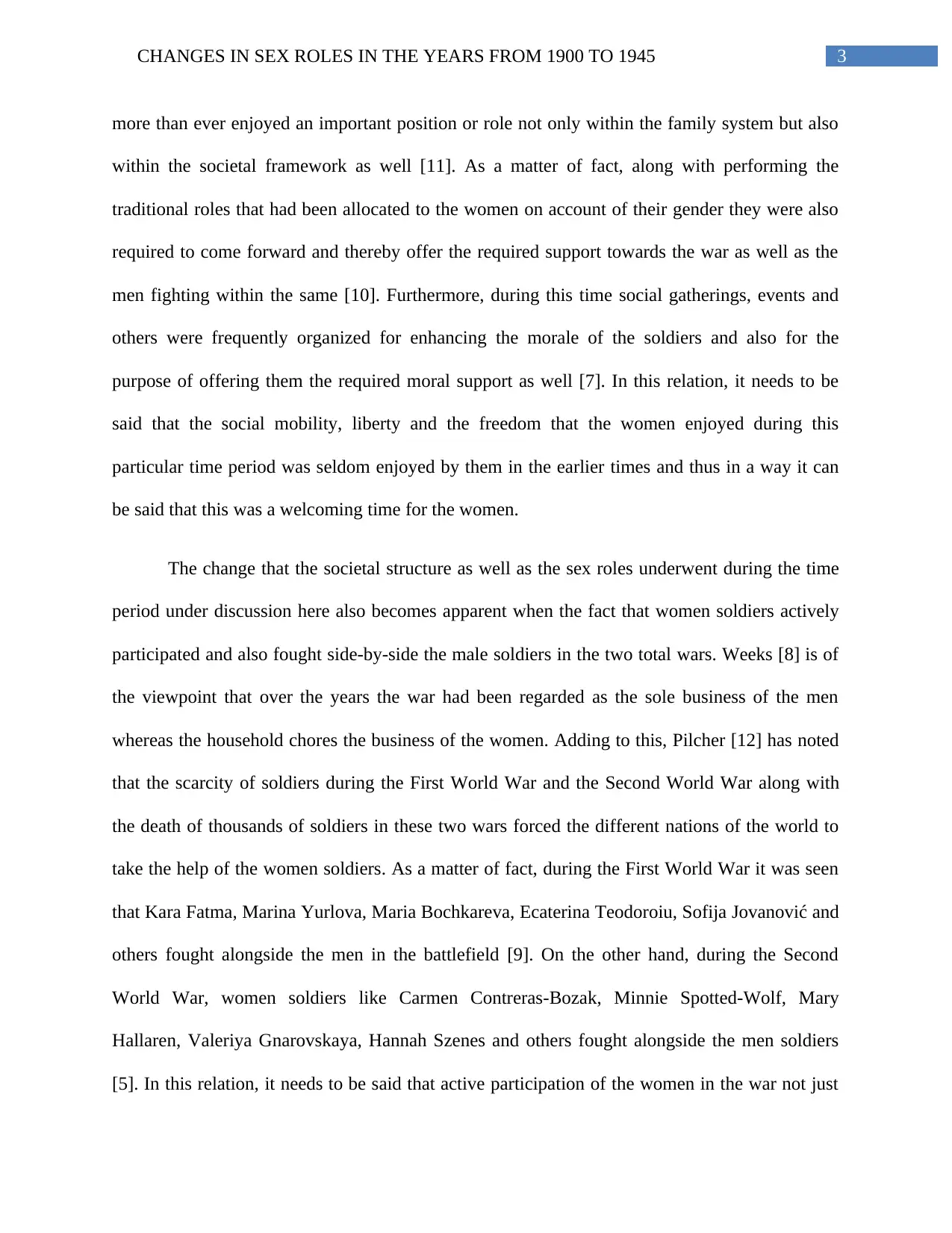
3CHANGES IN SEX ROLES IN THE YEARS FROM 1900 TO 1945
more than ever enjoyed an important position or role not only within the family system but also
within the societal framework as well [11]. As a matter of fact, along with performing the
traditional roles that had been allocated to the women on account of their gender they were also
required to come forward and thereby offer the required support towards the war as well as the
men fighting within the same [10]. Furthermore, during this time social gatherings, events and
others were frequently organized for enhancing the morale of the soldiers and also for the
purpose of offering them the required moral support as well [7]. In this relation, it needs to be
said that the social mobility, liberty and the freedom that the women enjoyed during this
particular time period was seldom enjoyed by them in the earlier times and thus in a way it can
be said that this was a welcoming time for the women.
The change that the societal structure as well as the sex roles underwent during the time
period under discussion here also becomes apparent when the fact that women soldiers actively
participated and also fought side-by-side the male soldiers in the two total wars. Weeks [8] is of
the viewpoint that over the years the war had been regarded as the sole business of the men
whereas the household chores the business of the women. Adding to this, Pilcher [12] has noted
that the scarcity of soldiers during the First World War and the Second World War along with
the death of thousands of soldiers in these two wars forced the different nations of the world to
take the help of the women soldiers. As a matter of fact, during the First World War it was seen
that Kara Fatma, Marina Yurlova, Maria Bochkareva, Ecaterina Teodoroiu, Sofija Jovanović and
others fought alongside the men in the battlefield [9]. On the other hand, during the Second
World War, women soldiers like Carmen Contreras-Bozak, Minnie Spotted-Wolf, Mary
Hallaren, Valeriya Gnarovskaya, Hannah Szenes and others fought alongside the men soldiers
[5]. In this relation, it needs to be said that active participation of the women in the war not just
more than ever enjoyed an important position or role not only within the family system but also
within the societal framework as well [11]. As a matter of fact, along with performing the
traditional roles that had been allocated to the women on account of their gender they were also
required to come forward and thereby offer the required support towards the war as well as the
men fighting within the same [10]. Furthermore, during this time social gatherings, events and
others were frequently organized for enhancing the morale of the soldiers and also for the
purpose of offering them the required moral support as well [7]. In this relation, it needs to be
said that the social mobility, liberty and the freedom that the women enjoyed during this
particular time period was seldom enjoyed by them in the earlier times and thus in a way it can
be said that this was a welcoming time for the women.
The change that the societal structure as well as the sex roles underwent during the time
period under discussion here also becomes apparent when the fact that women soldiers actively
participated and also fought side-by-side the male soldiers in the two total wars. Weeks [8] is of
the viewpoint that over the years the war had been regarded as the sole business of the men
whereas the household chores the business of the women. Adding to this, Pilcher [12] has noted
that the scarcity of soldiers during the First World War and the Second World War along with
the death of thousands of soldiers in these two wars forced the different nations of the world to
take the help of the women soldiers. As a matter of fact, during the First World War it was seen
that Kara Fatma, Marina Yurlova, Maria Bochkareva, Ecaterina Teodoroiu, Sofija Jovanović and
others fought alongside the men in the battlefield [9]. On the other hand, during the Second
World War, women soldiers like Carmen Contreras-Bozak, Minnie Spotted-Wolf, Mary
Hallaren, Valeriya Gnarovskaya, Hannah Szenes and others fought alongside the men soldiers
[5]. In this relation, it needs to be said that active participation of the women in the war not just
Paraphrase This Document
Need a fresh take? Get an instant paraphrase of this document with our AI Paraphraser
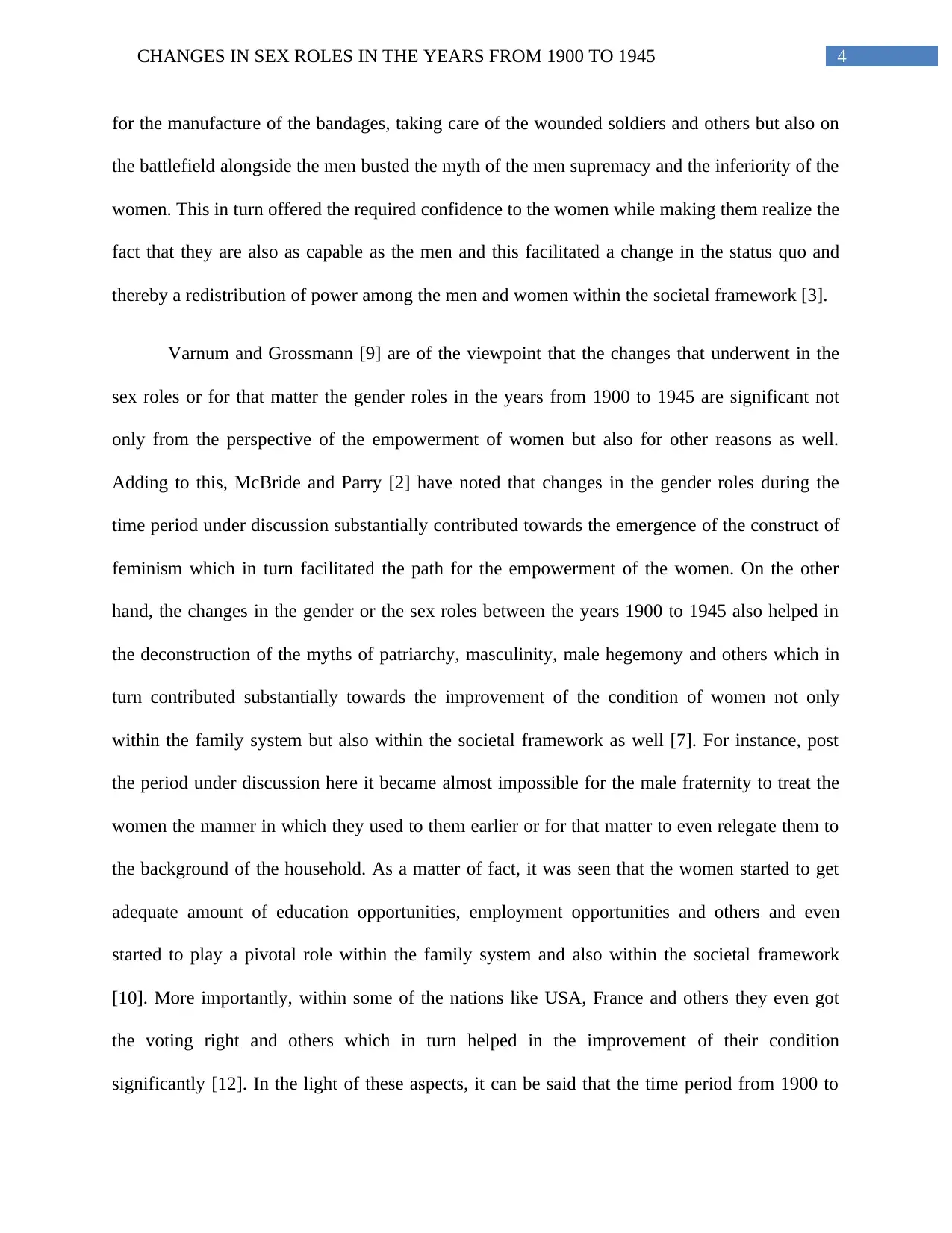
4CHANGES IN SEX ROLES IN THE YEARS FROM 1900 TO 1945
for the manufacture of the bandages, taking care of the wounded soldiers and others but also on
the battlefield alongside the men busted the myth of the men supremacy and the inferiority of the
women. This in turn offered the required confidence to the women while making them realize the
fact that they are also as capable as the men and this facilitated a change in the status quo and
thereby a redistribution of power among the men and women within the societal framework [3].
Varnum and Grossmann [9] are of the viewpoint that the changes that underwent in the
sex roles or for that matter the gender roles in the years from 1900 to 1945 are significant not
only from the perspective of the empowerment of women but also for other reasons as well.
Adding to this, McBride and Parry [2] have noted that changes in the gender roles during the
time period under discussion substantially contributed towards the emergence of the construct of
feminism which in turn facilitated the path for the empowerment of the women. On the other
hand, the changes in the gender or the sex roles between the years 1900 to 1945 also helped in
the deconstruction of the myths of patriarchy, masculinity, male hegemony and others which in
turn contributed substantially towards the improvement of the condition of women not only
within the family system but also within the societal framework as well [7]. For instance, post
the period under discussion here it became almost impossible for the male fraternity to treat the
women the manner in which they used to them earlier or for that matter to even relegate them to
the background of the household. As a matter of fact, it was seen that the women started to get
adequate amount of education opportunities, employment opportunities and others and even
started to play a pivotal role within the family system and also within the societal framework
[10]. More importantly, within some of the nations like USA, France and others they even got
the voting right and others which in turn helped in the improvement of their condition
significantly [12]. In the light of these aspects, it can be said that the time period from 1900 to
for the manufacture of the bandages, taking care of the wounded soldiers and others but also on
the battlefield alongside the men busted the myth of the men supremacy and the inferiority of the
women. This in turn offered the required confidence to the women while making them realize the
fact that they are also as capable as the men and this facilitated a change in the status quo and
thereby a redistribution of power among the men and women within the societal framework [3].
Varnum and Grossmann [9] are of the viewpoint that the changes that underwent in the
sex roles or for that matter the gender roles in the years from 1900 to 1945 are significant not
only from the perspective of the empowerment of women but also for other reasons as well.
Adding to this, McBride and Parry [2] have noted that changes in the gender roles during the
time period under discussion substantially contributed towards the emergence of the construct of
feminism which in turn facilitated the path for the empowerment of the women. On the other
hand, the changes in the gender or the sex roles between the years 1900 to 1945 also helped in
the deconstruction of the myths of patriarchy, masculinity, male hegemony and others which in
turn contributed substantially towards the improvement of the condition of women not only
within the family system but also within the societal framework as well [7]. For instance, post
the period under discussion here it became almost impossible for the male fraternity to treat the
women the manner in which they used to them earlier or for that matter to even relegate them to
the background of the household. As a matter of fact, it was seen that the women started to get
adequate amount of education opportunities, employment opportunities and others and even
started to play a pivotal role within the family system and also within the societal framework
[10]. More importantly, within some of the nations like USA, France and others they even got
the voting right and others which in turn helped in the improvement of their condition
significantly [12]. In the light of these aspects, it can be said that the time period from 1900 to
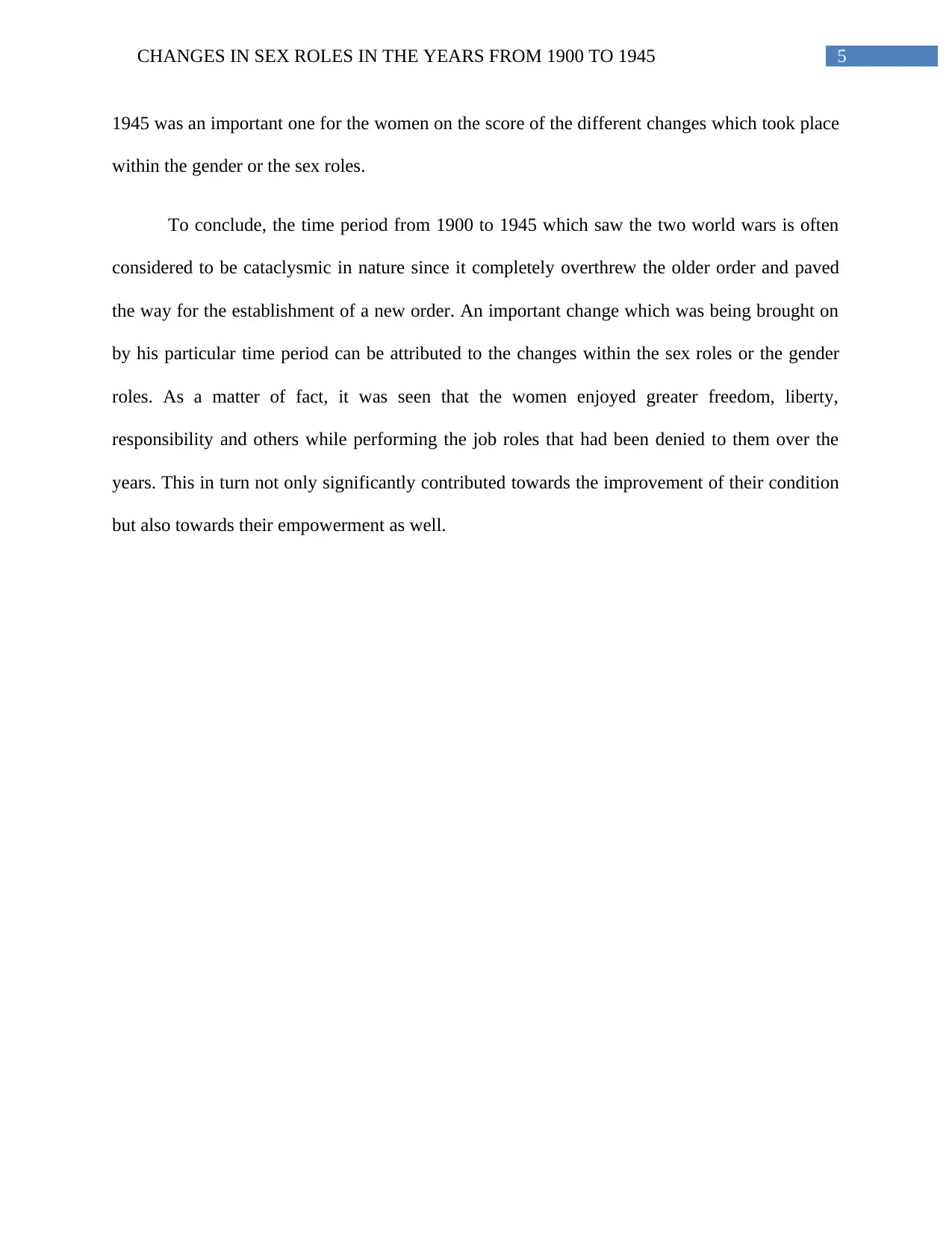
5CHANGES IN SEX ROLES IN THE YEARS FROM 1900 TO 1945
1945 was an important one for the women on the score of the different changes which took place
within the gender or the sex roles.
To conclude, the time period from 1900 to 1945 which saw the two world wars is often
considered to be cataclysmic in nature since it completely overthrew the older order and paved
the way for the establishment of a new order. An important change which was being brought on
by his particular time period can be attributed to the changes within the sex roles or the gender
roles. As a matter of fact, it was seen that the women enjoyed greater freedom, liberty,
responsibility and others while performing the job roles that had been denied to them over the
years. This in turn not only significantly contributed towards the improvement of their condition
but also towards their empowerment as well.
1945 was an important one for the women on the score of the different changes which took place
within the gender or the sex roles.
To conclude, the time period from 1900 to 1945 which saw the two world wars is often
considered to be cataclysmic in nature since it completely overthrew the older order and paved
the way for the establishment of a new order. An important change which was being brought on
by his particular time period can be attributed to the changes within the sex roles or the gender
roles. As a matter of fact, it was seen that the women enjoyed greater freedom, liberty,
responsibility and others while performing the job roles that had been denied to them over the
years. This in turn not only significantly contributed towards the improvement of their condition
but also towards their empowerment as well.
⊘ This is a preview!⊘
Do you want full access?
Subscribe today to unlock all pages.

Trusted by 1+ million students worldwide
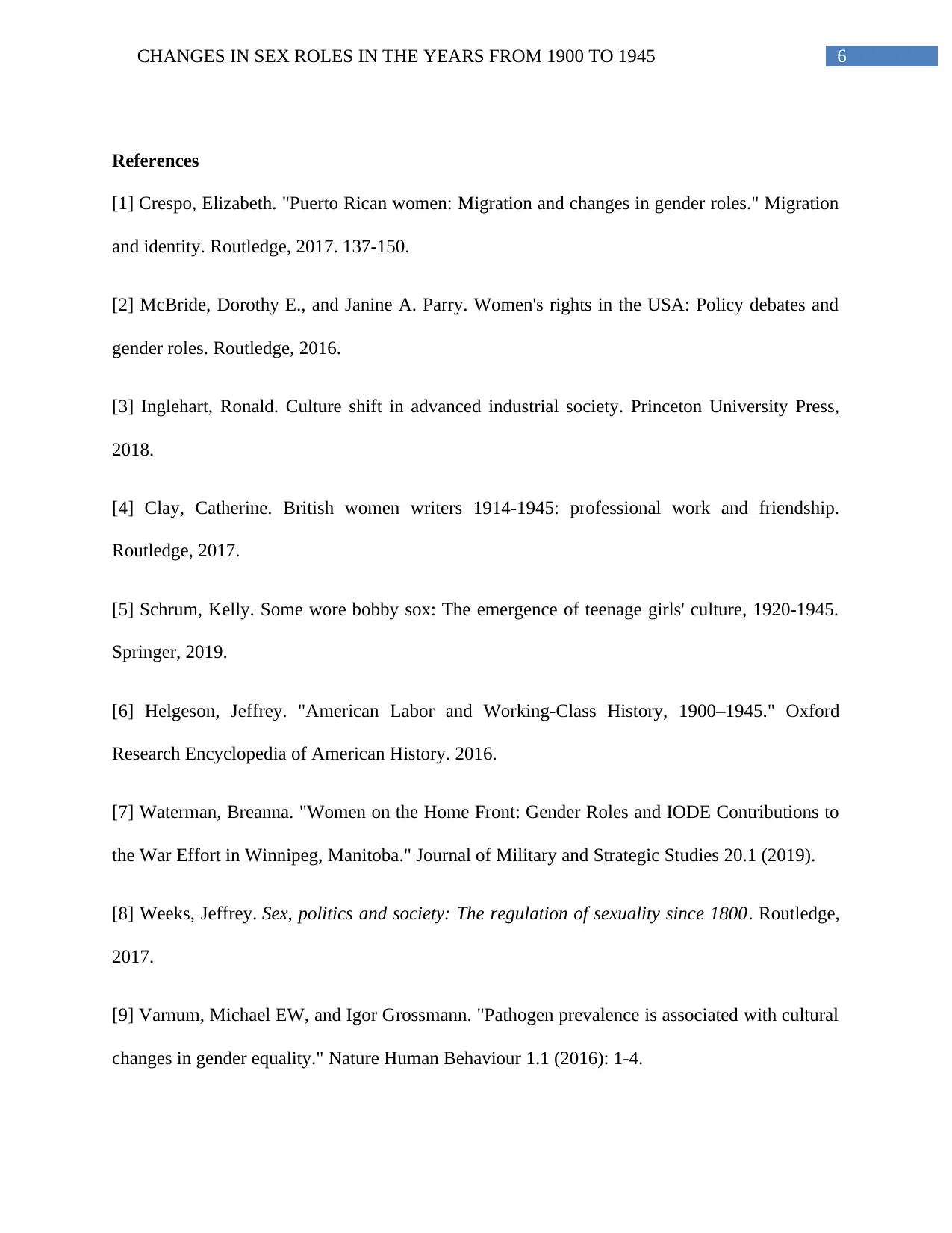
6CHANGES IN SEX ROLES IN THE YEARS FROM 1900 TO 1945
References
[1] Crespo, Elizabeth. "Puerto Rican women: Migration and changes in gender roles." Migration
and identity. Routledge, 2017. 137-150.
[2] McBride, Dorothy E., and Janine A. Parry. Women's rights in the USA: Policy debates and
gender roles. Routledge, 2016.
[3] Inglehart, Ronald. Culture shift in advanced industrial society. Princeton University Press,
2018.
[4] Clay, Catherine. British women writers 1914-1945: professional work and friendship.
Routledge, 2017.
[5] Schrum, Kelly. Some wore bobby sox: The emergence of teenage girls' culture, 1920-1945.
Springer, 2019.
[6] Helgeson, Jeffrey. "American Labor and Working-Class History, 1900–1945." Oxford
Research Encyclopedia of American History. 2016.
[7] Waterman, Breanna. "Women on the Home Front: Gender Roles and IODE Contributions to
the War Effort in Winnipeg, Manitoba." Journal of Military and Strategic Studies 20.1 (2019).
[8] Weeks, Jeffrey. Sex, politics and society: The regulation of sexuality since 1800. Routledge,
2017.
[9] Varnum, Michael EW, and Igor Grossmann. "Pathogen prevalence is associated with cultural
changes in gender equality." Nature Human Behaviour 1.1 (2016): 1-4.
References
[1] Crespo, Elizabeth. "Puerto Rican women: Migration and changes in gender roles." Migration
and identity. Routledge, 2017. 137-150.
[2] McBride, Dorothy E., and Janine A. Parry. Women's rights in the USA: Policy debates and
gender roles. Routledge, 2016.
[3] Inglehart, Ronald. Culture shift in advanced industrial society. Princeton University Press,
2018.
[4] Clay, Catherine. British women writers 1914-1945: professional work and friendship.
Routledge, 2017.
[5] Schrum, Kelly. Some wore bobby sox: The emergence of teenage girls' culture, 1920-1945.
Springer, 2019.
[6] Helgeson, Jeffrey. "American Labor and Working-Class History, 1900–1945." Oxford
Research Encyclopedia of American History. 2016.
[7] Waterman, Breanna. "Women on the Home Front: Gender Roles and IODE Contributions to
the War Effort in Winnipeg, Manitoba." Journal of Military and Strategic Studies 20.1 (2019).
[8] Weeks, Jeffrey. Sex, politics and society: The regulation of sexuality since 1800. Routledge,
2017.
[9] Varnum, Michael EW, and Igor Grossmann. "Pathogen prevalence is associated with cultural
changes in gender equality." Nature Human Behaviour 1.1 (2016): 1-4.
Paraphrase This Document
Need a fresh take? Get an instant paraphrase of this document with our AI Paraphraser
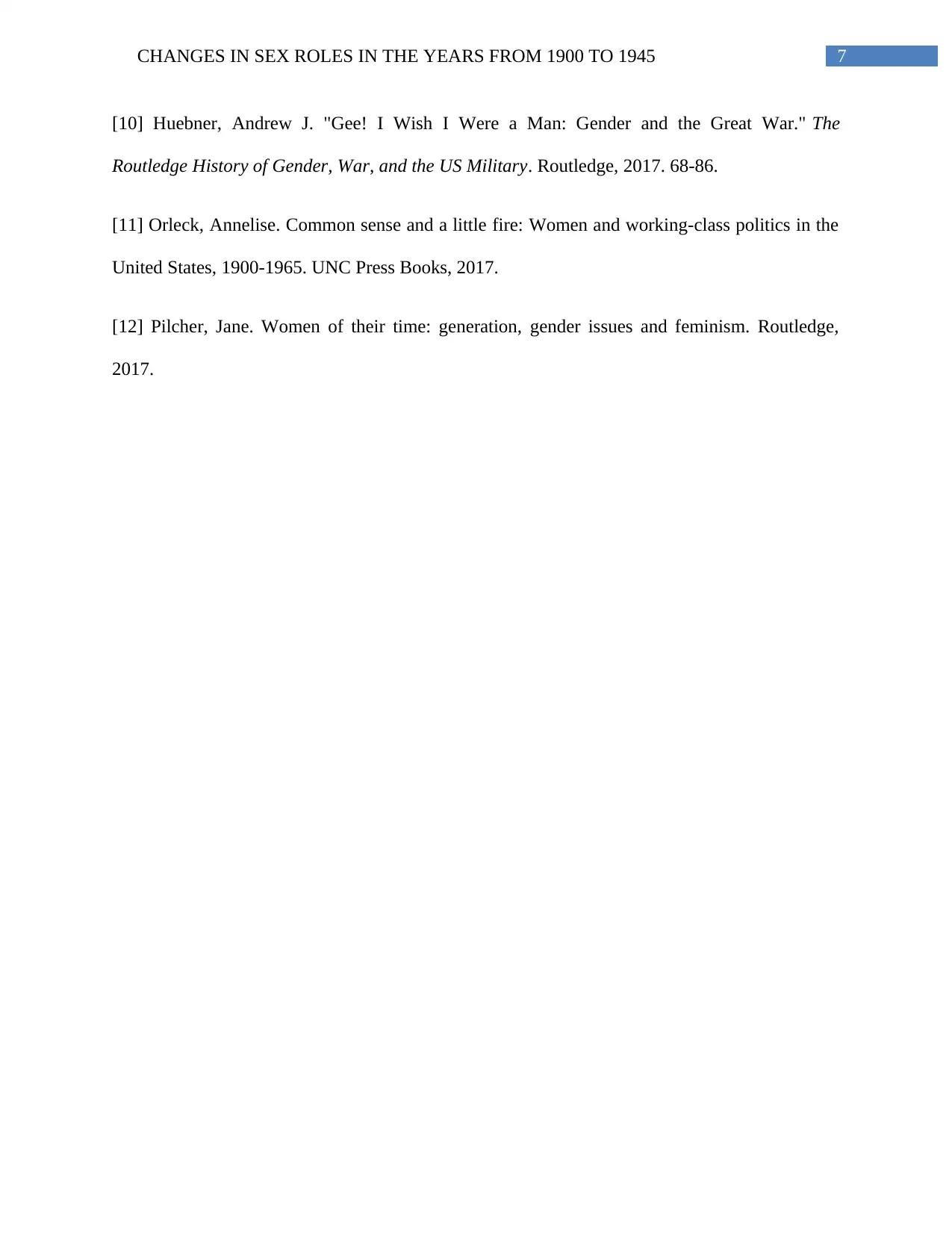
7CHANGES IN SEX ROLES IN THE YEARS FROM 1900 TO 1945
[10] Huebner, Andrew J. "Gee! I Wish I Were a Man: Gender and the Great War." The
Routledge History of Gender, War, and the US Military. Routledge, 2017. 68-86.
[11] Orleck, Annelise. Common sense and a little fire: Women and working-class politics in the
United States, 1900-1965. UNC Press Books, 2017.
[12] Pilcher, Jane. Women of their time: generation, gender issues and feminism. Routledge,
2017.
[10] Huebner, Andrew J. "Gee! I Wish I Were a Man: Gender and the Great War." The
Routledge History of Gender, War, and the US Military. Routledge, 2017. 68-86.
[11] Orleck, Annelise. Common sense and a little fire: Women and working-class politics in the
United States, 1900-1965. UNC Press Books, 2017.
[12] Pilcher, Jane. Women of their time: generation, gender issues and feminism. Routledge,
2017.
1 out of 8
Related Documents
Your All-in-One AI-Powered Toolkit for Academic Success.
+13062052269
info@desklib.com
Available 24*7 on WhatsApp / Email
![[object Object]](/_next/static/media/star-bottom.7253800d.svg)
Unlock your academic potential
Copyright © 2020–2025 A2Z Services. All Rights Reserved. Developed and managed by ZUCOL.





